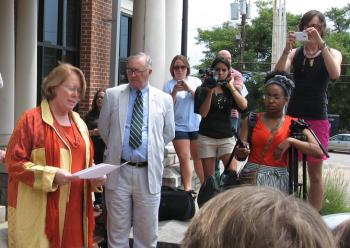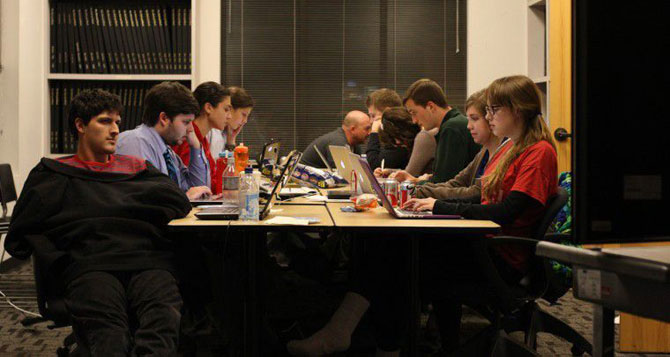When Polina Marinova, the editor-in-chief of The Red & Black, the University of Georgia’s independent student newspaper, read the memo, tears blurred her eyes.
Ed Stamper, an advertising executive and Red & Black board member hired as a consultant, had castigated the staff for publishing too much negative news and not enough positive pieces, and he suggested putting the professional editorial advisor in charge of the paper. The notion of prior review or any form of outside oversight threatened Marinova’s concept of independence as a student journalist. The staff felt blindsided.
Marinova resigned in protest, and top editorial staff members followed her out of the office over Stamper’s memo.
Within 24 hours, the student walkout became a national story. The New York Times, Huffington Post and renowned student media blogger Dan Reimold sounded off in a cacophony of scrutiny and criticism. One of the final vestiges of traditional student journalism had crumbled.
The walkout a little more than a year ago was the catalyst for essential changes The Red & Black has made since. The paper remains student-run and independent from the university. But it is still facing several challenges that plague many other college—as well as professional—newspapers across the country today: a decline in print readership and a decline in advertising revenue.
Is Print Dead?
In the fall of 2011, the R&B welcomed its readers to a “media revolution” when it made the switch from printing a daily publication to printing once a week with a focus on “digital first.”
The switch was a mutual decision among student staff and R&B board members, but critics described the change as too hasty and thought the paper should’ve made a more gradual transition.
Based on accounts from several student editors, including the R&B’s editor-in-chief last spring, Nicholas Fouriezos, both print pick-up rates and website traffic took a hit after the conversion.

Photo Credit: Blake Aued
Melita Easters (left) reads a statement at a press conference announcing the end of the student walkout at The Red & Black.
“A lot of us, including myself, felt like we needed to go back to daily, because even though it was really good for us to be more focused on the web, people weren’t picking up the paper, because they’d forget what day it came out on,” says Tiffany Michelle Stevens, a former R&B variety editor. “It wasn’t in their face all the time. There wasn’t a new paper all the time, so they wouldn’t pick it up as much, and our circulation numbers dropped, kind of extremely.”
The R&B board denied Flagpole’s request to verify the numbers, calling them “proprietary marketing information,” but a Fulton County Daily Report article written last August said online page views also went down, based on a readership survey commissioned by the R&B in March, 2012. According to the article, the R&B ranked at the bottom of all websites students visited for news.
Harry Montevideo, the R&B’s former publisher, projected that the switch would lower the paper’s net revenue by $105,342 but save $184,993 in printing and other costs, according to a thesis about the state of college media written by former University of Virginia student editor Matthew Cameron. Montevideo told the R&B board, according to Cameron, that not scaling back print production would mean “risking the future of the company,” because students were turning to digital devices to kill time during or between classes, rather than picking up the print edition.
According to tax returns, however, Montevideo’s projections were off. The nonprofit paper’s advertising revenue decreased by $163,016 between July 2011-June 2012, while its expenses dropped only $49,097. Including losses on investments, the R&B lost $67,351 the year after becoming a weekly. Montevideo took home a $161,540 salary that year, although he later said his salary had been reduced.
“I think that they were very unprepared for the switch to weekly,” says Lindsey Rogers Cook, former R&B multimedia editor.
The Memo
No student members were present at the R&B board meeting in the summer of 2012 when Stamper was hired as a business consultant to help develop a plan to stabilize the newspaper’s finances. (Stamper could not be reached for comment.)
The idea was that Stamper had the business acumen to turn things around. Stamper later described his memo as “direction about how to salvage a business.”
That summer is when the business side of the paper began influencing the editorial side, Fouriezos says. Student reporters and editors felt pressure about what they should cover.
“From people who were working in the office, they said it was pretty terrible. Ed Stamper was working in the office with them and handing down decisions from the board,” Stevens says. “And it was basically just [that] the board decided to take more of the reins than they had in the past, instead of working with us collaboratively the few times they would talk to us.”
On the morning of Aug. 15, 2012, Stamper wrote a draft of what he later called “talking points” for his meeting with Ed Morales, the R&B’s editorial adviser.
The document highlighted the “expectations for the editorial director,” Morales’ proposed new position. It said that the editorial director, not the student editor, would be “accountable for the final product” and said that he would be responsible for “correcting poor quality before publication.”
What many deemed to be the most controversial part of the memo referenced “content and quality standards,” which called for a balance of “good and bad,” good being in part “Content that is ABOUT our audience doing something unique, helpful, outstanding, new, dramatic… “ and bad is “content that catches people or organizations doing bad things. I guess this is ‘journalism,’” Stamper wrote, adding, “If in question, have more GOOD than BAD.”
The memo didn’t “sit well” with Marinova, she says. She spoke to Montevideo and Stamper to tell them that this was not what she had signed on for as editor-in-chief.
“Honestly, I wanted The Red & Black to continue as it was for the future generations of student journalists there, because I had a really good experience when I was a freshman, and I just wanted some of my friends who were freshmen to live in that environment and grow in that environment,” Marinova says.
With tears rolling down her face, Marinova assembled her staff in the conference room to tell them of the looming threat of prior review and that she had resigned. Everyone followed her out the door.
Dirty Laundry
Within an hour, the students created a brand on Twitter, Facebook and WordPress known as “The Red & Dead.”
A statement from Marinova as the “former editor-in-chief,” along with a scanned copy of the Stamper memo were posted to the website. It registered close to 50,000 page views in less than a day. The students would return on three conditions: a guarantee of no prior review, Stamper’s resignation and student voting rights in board meetings.
The following day, Montevideo released a statement explaining that the R&B was at the center of a “miscommunication” and said there would be “an open house and discussion” at their office the next day.
A media circus and public relations nightmare ensued in the offices of the R&B on Aug. 17, 2012. In addition to the local media presence and several prominent R&B alumni, the Society of Professional Journalists also sent a representative.
Red & Dead staffers, among other students like Joshua Buce, who covered the event for Grady News Source, piled into the building. The open house was closed quickly, and Montevideo got into a physical altercation with Buce, who refused Montevideo’s request to turn off his camera as he was leaving the building. They both ended up on the floor, and photos of Montevideo with his hand on Buce’s neck went viral.
The fight for student independence was over. The students had won. Stamper resigned, the board promised no prior review and, as outlined in the R&B’s bylaws, students would have a seat on the board, though without voting rights.
“It was like going back to an old boyfriend’s house after a break-up,” says Alex Laughlin, the former R&B recruitment editor.
An awkward tension filled the newsroom. The students felt a subtle animosity in the air and more scrutiny of their decisions. “When we first went back and it was still bad, it was depressing,” Cook says.
Shortly after the walkout ended, another controversy arose when University of Florida boosters paid for a full-page color ad in the R&B to mock the Georgia Bulldogs days before last year’s game between the bitter rivals in Jacksonville. It drew harsh criticism from readers, and some avid football fans even promised to boycott the R&B.
“Harry said that it was Lindsey’s fault that the ad had got so much attention because she posted it on Facebook,” Laughlin says. “I feel like Harry just didn’t want Lindsey near the computer in general because, you know, she’s dangerous. She made the Red & Dead campaign go viral.”
The board picked Fouriezos to be the editor-in-chief for the spring 2013 semester. Nick Watson, the current editor-in-chief, was chosen to be the managing editor. (He declined interview requests.) Cook was left out in the cold.
In college newsrooms, there’s a natural turnover as students graduate and move on to other things, but many students who are still around this fall—some whom were involved in the Red & Dead movement—never returned. If the board was trying to get rid of the troublemakers, mission accomplished.
“I think that’s the sad part, that part that made all of us think again about working there. Did we actually change the course for the Red & Black? I don’t know,” Cook says. “I think that we did ultimately, but it took a year.”
New Blood
The R&B got a fresh perspective when it added eight new board members, all of whom were once student staffers, in February. Among them was Chuck Reece, the first student to hold the editor-in-chief position when the R&B became independent in the summer of 1980. The board, according to many students, was just out of touch with the day-to-day operations.
“The truth is, in the grand scheme of things, I think the shakeup that resulted was a very good thing for the paper,” Reece says.
In June, Montevideo resigned as publisher after 30 years. Depending on who is asked, it’s unclear whether this was a mutual decision or if Montevideo was forced out. Montevideo could not be reached for comment.
“We’re going to need professional leadership with a different set of skills than Harry had, or that anybody in that traditional publisher role would’ve had, to move the paper in the right direction,” Reece says.
Reece and Melita Easters, chairwoman of the R&B’s board, both noted that the paper is in a fortunate position financially as a result of Montevideo’s careful stewardship, with reserve funds “in the millions.”
Natalie McClure, the R&B’s advertising director since 2008, was officially promoted to general manager recently after holding the position in the interim. Her newly developed cross-media advertising packages have already resulted in a positive outcome, Reece says.
“In the latest data, we’ve actually begun to see the advertising trend line turn back up a little bit,” he says.
The R&B board recently announced that they are working on new bylaws to allow student ex-officio board members voting rights, which was the final goal of the Red & Dead group. The new bylaws are expected to be adopted this November.
Easters also mentioned a “future cooperation between the Red & Black and with the Grady College… the fruits of those efforts will become evident over the coming months.” The collaboration will be “a cross-promotional opportunity,” McClure says.
The new dean of UGA’s Grady College of Journalism, Charles Davis, describes it as an informal partnership, saying that he values the R&B’s independence. It could include workshops and learning opportunities from Grady professors that surpass the standard curriculum, he says.
“I think there’s all kinds of ways in which we can narrow the distance—rolling out the red carpet to make sure they know we value the work that they do,” Davis says. “I will just be looking for every opportunity to deepen the relationship.”
Like what you just read? Support Flagpole by making a donation today. Every dollar you give helps fund our ongoing mission to provide Athens with quality, independent journalism.










